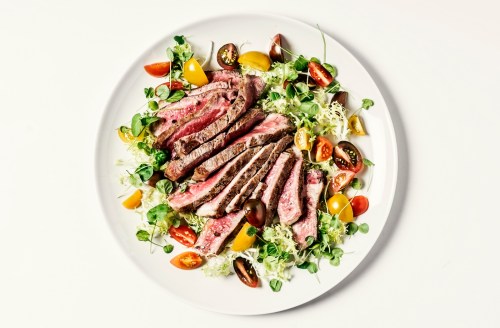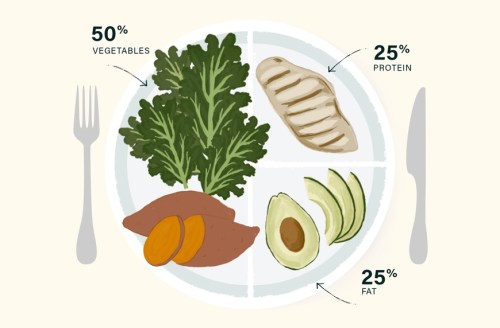Here’s what a healthy plate looks like on the Paleo diet
Need some help following the Paleo diet? Two registered dietitans share examples of Paleo diet macros and sample meal ideas to keep things healthy.

If someone had suggested 10 years ago to “eat like a caveman,” they probably would have been met with a fair amount of raised eyebrows and skepticism. Fast-forward to today, and that’s the entire ethos of the very popular Paleo diet.
“The Paleo diet is based on the premise of eating real food, as close to our ancestors as possible. It removes common inflammatory foods like grains, dairy, soy, processed vegetable oils, refined sugar and legumes,” says Samantha Presicci, MCN, RD, LD, CPT, lead dietitian at Snap Kitchen. The eating plan comes with a decent amount of potential benefits, she says, including reduced inflammation and improved digestion and blood sugar control. (However, some experts say more research is needed.)
It might especially beneficial for those struggling with GI issues. “Some people, including some of my clients with digestive health issues and autoimmune disease, report feeling better on a Paleo diet, but this is all anecdotal,” says EA Stewart, MBA, RD, CLT. She also likes the emphasis on whole foods and reduction of added sugars and highly processed foods, neither of which do any favors for people’s health.
While the initial Paleo diet “rules” were pretty strict, Stewart says there are many interpretations out there that are more manageable. “There are no hard-and-fast rules about the percentage of foods and macronutrients that should be eaten on the Paleo diet,” she says. A person’s Paleo macros needs could vary on the day and one’s activity level, adds Presicci.
Still, it can be tricky to know where to start with Paleo eating—which is why we asked Stewart and Presicci to help us build a healthy plate. (Because yes, even though you’re eating like a caveman, using plates and utensils is definitely encouraged.)
Start with lots of non-starchy vegetables
“As with any dietary lifestyle, your plate should be at least half veggies, since they provide lots of micronutrients that are beneficial for mitochondrial health and overall body function,” says Presicci. This is even truer on Paleo, when carbs are limited. Stewart agrees, and says she has her clients aim for two to three cups (or more!) of vegetables every day.
Most vegetables are fair game, but Presicci says people on Paleo should prioritize non-starchy vegetables like leafy greens, broccoli, cauliflower, and Brussels sprouts. That’s because the starchier kind (like sweet potatoes) will count more as a carb in this situation.
“In regards to the paleo diet, most all vegetables and fruit are allowed, although most versions omit white potatoes, but allow sweet potatoes. One other exception is corn, which can also be considered a grain, and is not allowed on a paleo diet,” Stewart adds.
Get your carbs from starchier veggies
Healthy carbohydrate foods provide energy and fiber to the body. But on Paleo, sources of carbs are a bit limited, since grains, legumes, corn, and white potatoes are restricted or extremely limited. So…what’s on the table instead?
“When following a Paleo framework your main source of carbohydrates will be starchy veggies like sweet potatoes, yucca, onion, parsnips, plantains, beets and more. There are plenty of options! Nuts, seeds and fruit will also provide carbohydrates,” says Presicci. You can figure about a fourth of the plate might consist of these starchy veggies or carbs, and this could factor into the half of the plate made up of vegetables, she says.
Of course, there is no hard-or-fast rule with Paleo diet macros, says Stewart. “Some people do well with higher carbs, and some do better with lower carbs, so a good starting point is 30 to 55 percent [of your daily diet]” she says. Presicci agrees: “Some people won’t need any starchy veggies—low activity, for example—so it’s not the same for everyone,” she says. “Additionally, lots of foods have carbs in them that might also fit in the protein or fat category, like coconut and nuts and seeds.”
Fill up a quarter of your plate with protein
Protein needs are individual, but a good starting point is 0.8 grams of protein per kilogram of body weight, or 0.36 grams per pound. This would equate to 54 grams per day for a 150-pound woman, says Stewart.
“I find many of my clients don’t get enough protein at breakfast, which helps prevent hunger throughout the day, and less overeating at night, so I suggest spreading protein intake throughout the day. This might be 20-plus grams at breakfast, 20-plus at lunch, and 15-plus at dinner,” Stewart says.
This translates to about a fourth to a third of the plate, depending on your individual needs. Go for plant-based protein from nuts and seeds (you’ll also get a little bit from vegetables), eggs, lean meats, including grass fed/organic meat, poultry, and fish like wild salmon, sardines, and others that are rich in omega-3 fatty acids.
Incorporate fats throughout each meal
Fat can either replace the carbs on your plate or be in addition to them, says Presicci. “Great sources of fat on a Paleo diet include avocado, nuts and seeds, coconut, coconut oil, avocado oil, pastured animal fats, grass-fed ghee, olives, and extra-virgin olive oil,” she says.
Stewart agrees, saying a typical range might be 20 to 40 percent of calories from fat with an emphasis on monounsaturated fats and polyunsaturated fats, which come from avocados, olives, nuts, and seeds, and fatty fish, as well as poultry, grass fed meat, and wild game. These would be sprinkled throughout, so it’s hard to give a set macro ratio, but Presicci says fats should be about a fourth of the plate.

What does a sample plate look like?
A very generalized example: Presicci says a fourth of your plate would be protein, half would veggies (with some carby vegetables as part of that) and another fourth is healthy fat, sprinkled around in protein sources and cooking oils and sauces. However, since paleo does emphasize protein, and especially if you are active, you can add in more protein as you see fit, while still keeping enough carbs for your body and some fats.
For breakfast, that might look like two eggs sautéed in avocado oil with spinach and fresh herbs, a half cup of coconut milk yogurt topped with blueberries, hemp seeds, and pumpkin seeds. Lunch could be a salad with chopped kale, shredded cabbage, and four to six ounces of chicken breast, topped with slivered almonds and some olive oil. Dinner could be some a sheet-pan dinner of salmon, sweet potato, and green beans roasted together with some dairy-free pesto.
Are these proportions universal for all meals?
Not at all! It varies by the individual—their energy production, appetite, hormonal changes, and more—all of which can make the ratios change on a daily basis. But this is a good model to keep in mind for forming healthy Paleo meals when you’re feeling stuck.
“This isn’t an exact science, and part of the beauty of Paleo is that in eating real food, you get to focus less on macros,” says Presicci. Sounds pretty sweet to me.
Here’s how a Mediterranean plate compares to the Paleo plate. And here’s how to tell the difference between Paleo and Whole30 (because they’re pretty similar, TBH.)
Sign Up for Our Daily Newsletter
Get all the latest in wellness, trends, food, fitness, beauty, and more delivered right to your inbox.
Got it, you've been added to our email list.










